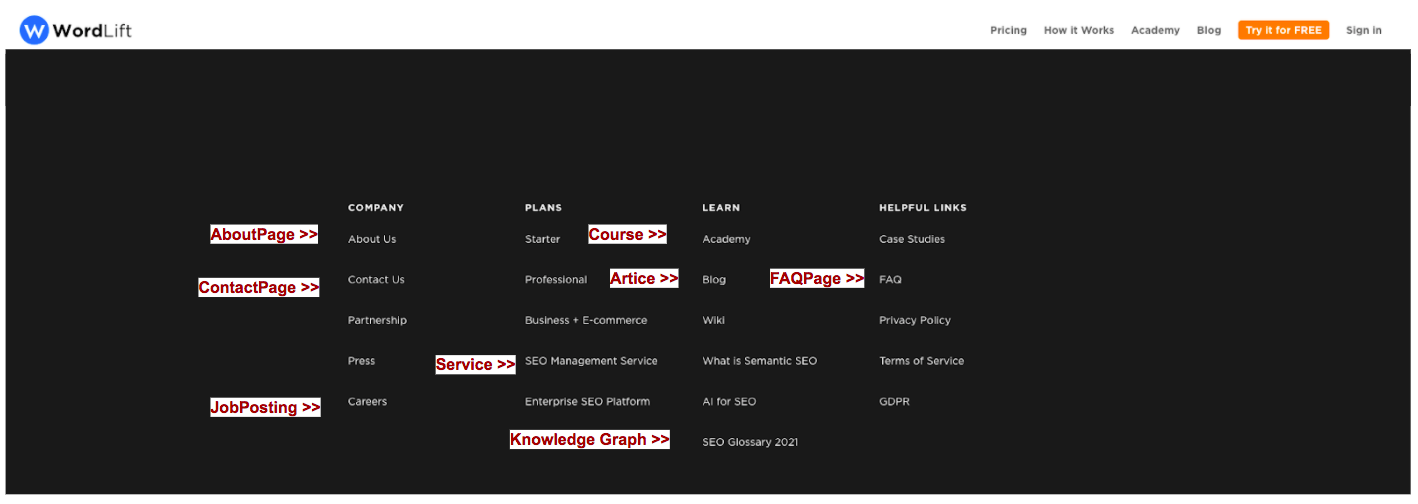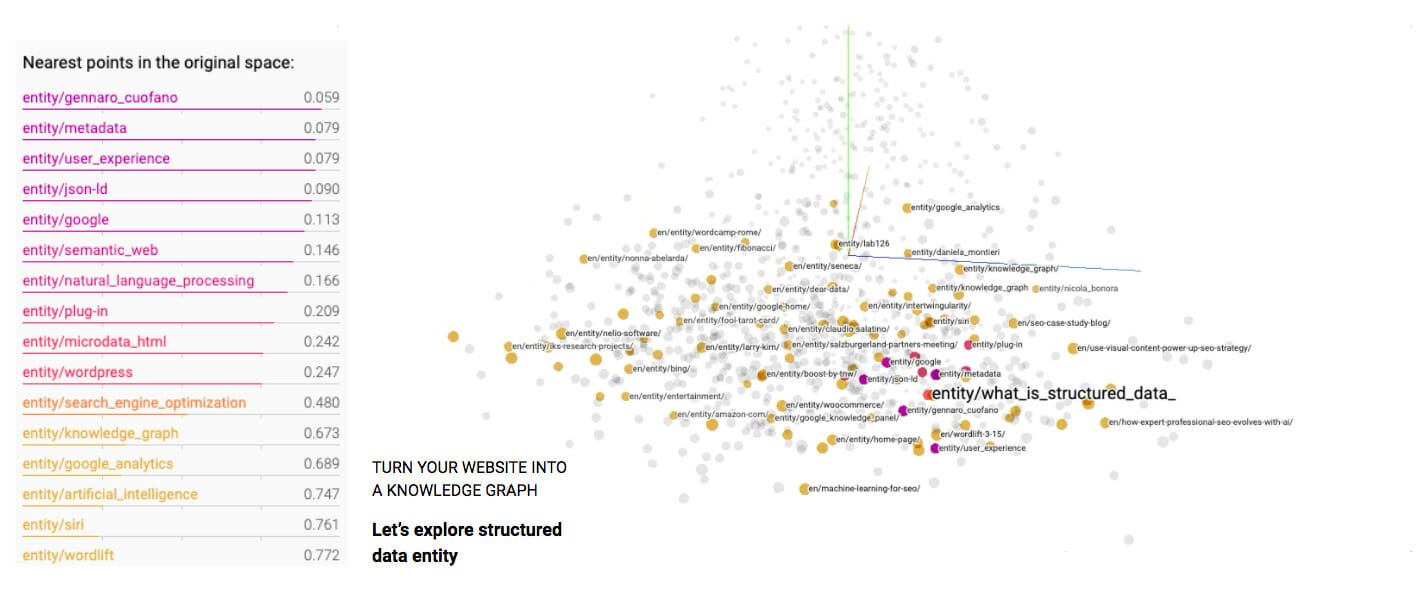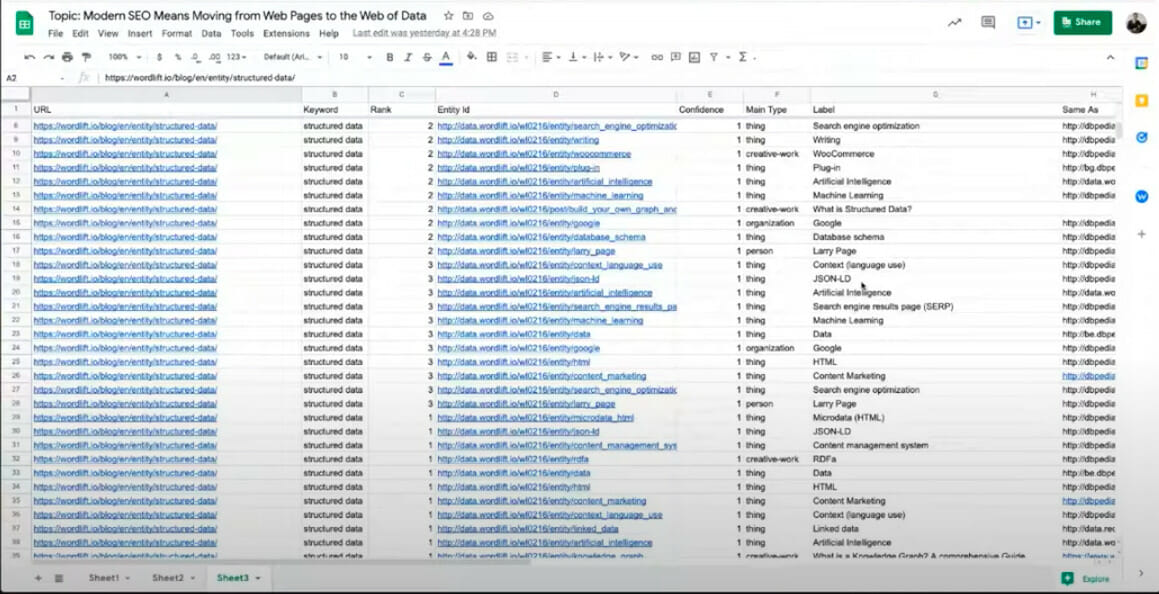Introduction
What you’ll learn:
- What is Modern SEO and how to make your website friendly for search engines;
- How to turn your website into a knowledge graph that will propulse your SEO strategy;
- Some best practices to optimize your website dataset and knowledge graph.
Is this content for you?
- If you want to understand what modern SEO means and why your website is not yet well organized;
- If you want to learn how to bring your website to the next level by adding structured data and building a Knowledge Graph;
- If you want to start having a dataset and using AI to analyze and cluster your content to improve your SEO and content strategy.
Table of Contents
- What is Modern SEO
- How to turn your website into a Knowledge Graph
- Will SEO be automated?
- How can I drive traffic to my website in 2022?
- Takeaway
What is Modern SEO
Modern SEO means making your content more intelligent, reasonable for Google and search engines, and offering a great user experience. How is it possible? By adding structured data and building a Knowledge Graph, your website will speak the native language of search engines to understand what you are talking about and give users rich results showing them what they are looking for.
You have content, navigational structure, sitemaps. And you think it is everything you need for your SEO strategy, but it isn’t. You have many unstructured data that machines can’t fully understand or grasp all the concepts and crawlers can’t find.
You need to find a way to tell a better story, not just to the users but also to the machines, and make sure that the content itself and the things you are talking about are disambiguated. But that’s often not the case, or at least not yet. And those machines have to go deeper to understand the context you are talking about in your content.
So the answer is: what can you do to make your content understandable for machines?
You need to start seeing your website and content from the eyes of the search engines. It means adding a dimension that makes your content clearer to the search engines. This webinar shows you how to turn your website into a Knowledge Graph to make your SEO strategy more effective.
How to turn your website into a Knowledge Graph
The first step is to analyze the content. What type of pages do you have? You have a contact page, an about us page, a service page, etc. All of them need structured data to be understood from the search engine.
The second step is to organize your content. By adding schema markup and using specific entity types you allow Google and search engines to have information to return users’ search results relevant to what they are looking for. As a result, you collect data for machines and meaningful content for users. There are two sides of the same coin: content needs to speak to users, but machines need to read it in the proper context to get to the right one. Markups are an effortless way to do that.
Below is an example of how you can organize the pages of your website using the different entities type of schema markup.
As you can also see in the image above, for the blog, you can add the entity type Article; for the FAQ, you can use the entity type FAQPage. If you have open job positions, you can include the entity type JobPosting, etc. In this way, you are building a vocabulary of entities where each page is assigned its own identity. This is a key point: to convert what you already have on your website into entities and start building your personal Knowledge Graph.
Schema markup is not just something you put on the pages of a site and hopefully make them rich. Structured data makes your website talk to search engines, but at the same time, it also helps you categorize and organize your content and create more value.
What is good content? It’s content that will move users in the right direction. And it matches the intent of what the search engine is looking for. By following this process, you can be sure that you’re embodying the things that matter and speaking in the language that your users want. And there, we’re also speaking to the language that search engines want and understand as well.
Then the third step is to build a Knowledge graph. When you start building the knowledge graph, you’re not just giving a notation or enriching the existing structure. Still, you’re allowing sessions to understand the relationships between these different entities on your website. So it’s kind of like a glossary that represents all the essential information you have on a page.
In addition to the structure data you’re adding, you are creating your website dataset. Each of these entities has a unique ID and has its position in the knowledge graph. When you add a markup on an article, you’re also giving search engines many entries points to understanding the information you have on the website. And this is what creates the data set that the search engine likes too much.
For example, below is a template that can show the data set on our website.
Here is the link for the TendoFlow Projector.
This is the entity that I can pull out, and I can figure out how this entity is related to the rest of the content on my website. It also allows me to see what’s missing and what I could add to improve the structure of my Knowledge Graph. I can also start linking these entities by annotating them in related articles. One more thing you can do with this structure is to analyze the visits coming to the website from the entities to optimize the investment.
That’s very different from the static way of analyzing websites using just the pages, for example, or any other metrics that Google analytics.
Having the entities is excellent. They’re great to mark up. They’re great for adding extra information, but it’s the relationships between these entities that create new value. And it’s the relationships that help you take your website content to another level. Organize your content marketing into a Knowledge Graph to get more visibility and engagement. Use the knowledge graph to see those connections and maybe see the disconnects or the deeper elements within the data to customize the journey for users to ensure they get what they want.
Here, for example, we’re analyzing the top-ranking pages for this keyword on the server and pulling out what entities are from those pages.
This is very cool. Then once you have those things here, you can see which entities are already there and which ones you can cover. So you will enrich your dataset or knowledge graph with the new entities that you are not managing right now. So this is where it’s a public on-page SEO guide, but based on the entity itself to enrich the knowledge graph and improve the ranking of that period that you already have on your website.
Will SEO be automated?
AI can help you to pull out data and automate your SEO, but it can’t do everything. You know your market and your audience. Your knowledge and input are essential to building your modern SEO strategy with AI.
How can I drive traffic to my website in 2022?
Not all traffic is equal, there is quality traffic, but there is also junk traffic. It’s not a magic formula that does everything by itself. You need to provide value to your audience, and indeed the Knowledge Graph helps to go in this direction. The key is to make sure that the data is clean and quality because only then can you get relevant results for your business.
Takeaway
- Say no to overloading. Be smart and choose the proper type of entities for each content on your site.
- Don’t rush to see results. Google needs time to scan and index the website. Likewise, it needs time to believe and understand what your content is about. Once it starts understanding, it will start playing the game with you.
Remember, even when you’re building your knowledge graph, you’re contributing to the web, and you’re making the web better by providing more information accessible by the search engine, and it’s helping the user experience for all the people on the different sessions.
Watch the recording of the webinar Modern SEO Means Moving from Web Pages to the Web of Data with Jason Barnard, Doreid Haddad, and Ryan Shelley.


